In Wisconsin, a captivating array of nocturnal sentinels graces the diverse landscapes, 11 species of owls, each with its own unique charm and ecological role.
From the iconic Great Horned Owl to the elusive Boreal Owl, these feathered residents silently navigate the night, contributing to the delicate balance of ecosystems.
In this exploration, we unveil the identities, habitats, and significance of these 11 owl species, shedding light on their roles as hunters, biodiversity guardians, and cultural symbols.
Join us on a journey through the Wisconsin wilderness as we delve into the enchanting realm of these remarkable birds, deciphering their ecological importance and unraveling the mysteries that make them integral to the state’s natural heritage. Stay focused.
11 Owls in Wisconsin
Discover the enchanting world of owls in Wisconsin as we delve into the lives of these remarkable birds. From the iconic Great Horned Owl to the elusive Boreal Owl, each species brings its own unique charm.
Explore their habitats, hunting strategies, and the conservation efforts to preserve these captivating avian residents.
1. Great Horned Owl

- Scientific name: Bubo virginianus
- Population: Common in Wisconsin
- Life span: 5 to 15 years in the wild
- Size: 18 to 25 inches tall
- Weight: 2 to 5.5 pounds
- Food: Mainly mammals like rabbits, squirrels, and rodents; also birds, reptiles, and insects
- Wingspan: 3.3 to 4.8 feet
- Status: Secure
The Great Horned Owl, a prominent raptor in Wisconsin, thrives in diverse habitats, from forests to urban areas. With powerful talons and keen eyesight, it is a formidable nocturnal hunter.
These owls exhibit a monogamous mating behavior and form pairs that often stay together for life. Nesting in trees or abandoned nests of other large birds, they raise their young, known as owlets, with remarkable care.
Great Horned Owls are versatile predators, adapting their diet to the local abundance of prey. Their hooting calls resonate through the night, contributing to the distinctive soundscape of Wisconsin.
2. Barn Owl
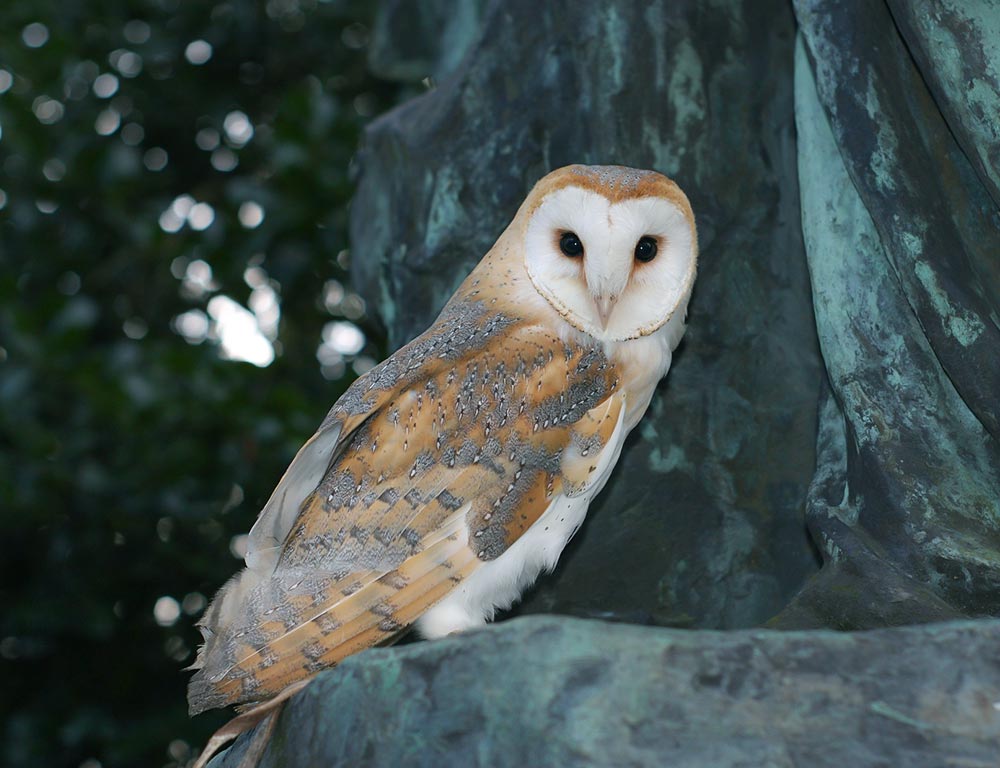
- Scientific name: Tyto alba
- Population: Declining in some areas
- Life span: Up to 10 years
- Size: 12.6 to 15.8 inches tall
- Weight: 14 to 24 ounces
- Food: Primarily small mammals like mice, voles, and shrews
- Wingspan: 38 to 45 inches
- Status: Declining
Barn Owls are easily recognizable by their heart-shaped facial disks and pale plumage. Preferring open habitats, they often inhabit barns, silos, and other man-made structures.
These silent fliers are expert hunters, relying on exceptional hearing to locate prey in complete darkness. Unfortunately, their populations are declining due to habitat loss and pesticide exposure.
Conservation efforts in Wisconsin aim to preserve suitable nesting sites and raise awareness about the importance of these elegant birds in pest control.
3. Barred Owl

- Scientific name: Strix varia
- Population: Stable in Wisconsin
- Life span: Up to 10 years
- Size: 16 to 24 inches tall
- Weight: 1 to 2.3 pounds
- Food: Small mammals, birds, amphibians, and invertebrates
- Wingspan: 38 to 49 inches
- Status: Secure
Barred Owls, with their distinctive “Who cooks for you?” hooting calls, inhabit mature forests in Wisconsin. They nest in tree cavities and have a preference for riparian areas.
Known for their adaptability, Barred Owls have successfully incorporated suburban environments into their territories. Their feather patterns provide excellent camouflage, making them effective hunters.
Barred Owls often hunt from perches or by gliding silently through the forest. Despite facing some threats, they currently maintain stable populations in the state.
4. Eastern Screech Owl
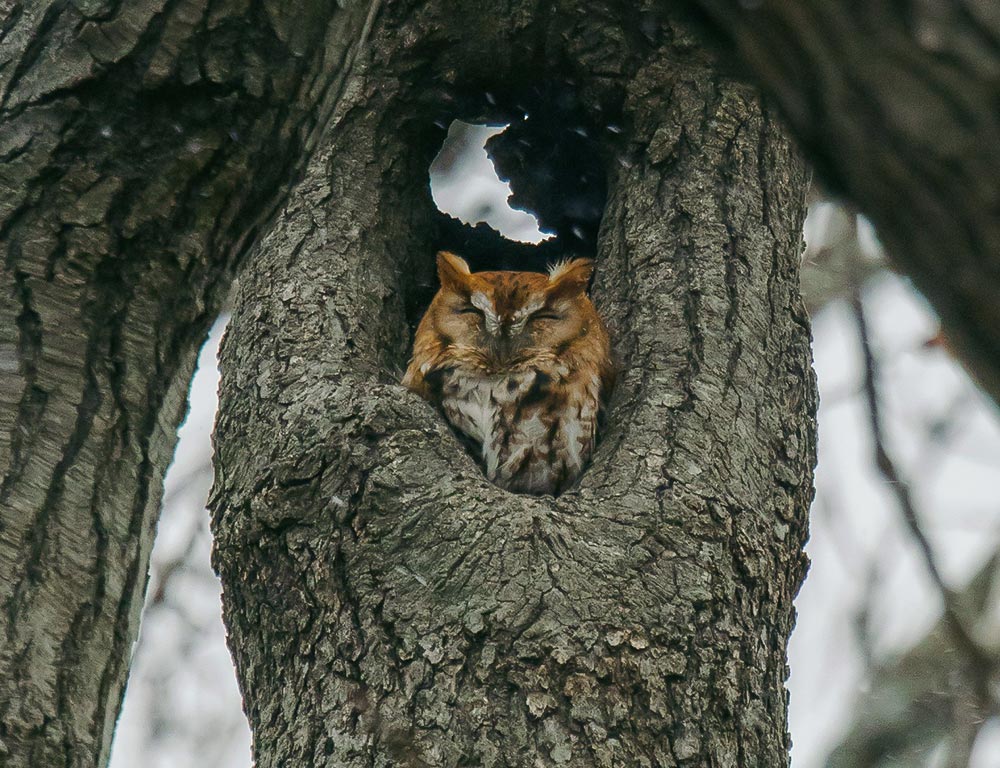
- Scientific name: Megascops asio
- Population: Common in suitable habitats
- Life span: 8 to 10 years
- Size: 6.3 to 9.8 inches tall
- Weight: 4 to 8 ounces
- Food: Insects, small mammals, birds, and amphibians
- Wingspan: 18 to 24 inches
- Status: Secure
The Eastern Screech Owl, with its small size and distinctive ear tufts, is found in various habitats, including woodlands, parks, and suburban areas.
Despite their name, these owls are not always vocal; they can produce soft trills or haunting whinnies. They are cavity nesters, utilizing tree holes or nest boxes. With excellent camouflage and an opportunistic diet, they are successful hunters.
Their adaptability to human-altered landscapes contributes to their common presence in Wisconsin. Conservation efforts focus on providing suitable nesting sites and raising awareness to protect these charming, small owls.
5. Snowy Owl

- Scientific name: Bubo scandiacus
- Population: Nomadic, varies with food availability
- Life span: Up to 10 years
- Size: 20.5 to 27.9 inches tall
- Weight: 3.5 to 6.6 pounds
- Food: Mainly lemmings; also birds, rabbits, and other small mammals
- Wingspan: 49.6 to 57.1 inches
- Status: Vulnerable
Snowy Owls are iconic Arctic birds that occasionally migrate south to Wisconsin during winter irruptions. Recognizable by their striking white plumage, they are well-adapted to cold environments.
Snowy Owls are highly skilled hunters, relying on keen eyesight and powerful talons. They primarily target lemmings in their Arctic breeding grounds.
In Wisconsin, they may switch to hunting other small mammals and birds. Conservation efforts focus on studying their movements during irruptions to understand better and protect these majestic birds.
6. Northern Saw-whet Owl

- Scientific name: Aegolius acadicus
- Population: Stable
- Life span: Up to 7 years
- Size: 7 to 8 inches tall
- Weight: 2.3 to 5 ounces
- Food: Mainly small mammals like mice and voles; also insects and birds
- Wingspan: 16.5 to 18.9 inches
- Status: Secure
The Northern Saw-whet Owl, named for its repetitive whistle that sounds like a saw being sharpened, is a small, nocturnal owl found in Wisconsin. Despite its small size, it’s an efficient hunter, capturing prey with its sharp talons.
These owls often inhabit coniferous and mixed woodlands, roosting in dense vegetation during the day. They are cavity nesters and may use abandoned woodpecker holes or nest boxes.
Their secretive nature and excellent camouflage make them challenging to spot. Conservation efforts involve monitoring their populations and protecting suitable habitats.
7. Great Grey Owl
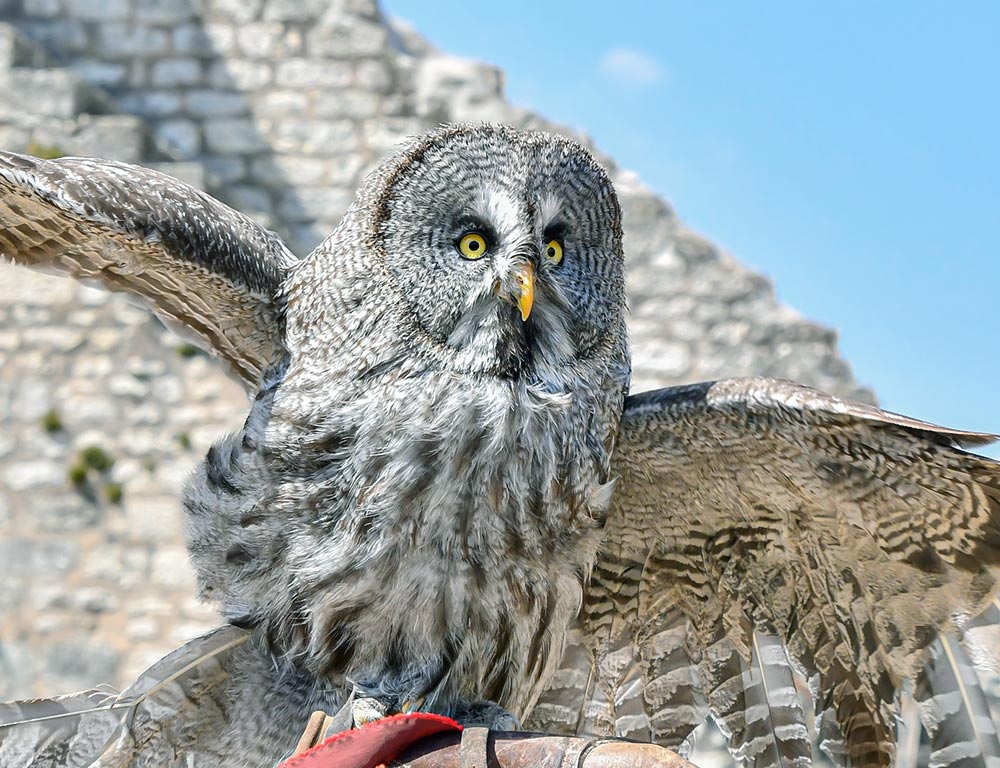
- Scientific name: Strix nebulosa
- Population: Generally stable, occasional irruptions
- Life span: Up to 10 years
- Size: 24 to 33 inches tall
- Weight: 1.5 to 3.5 pounds
- Food: Mainly small mammals, especially voles and mice
- Wingspan: 53.9 to 60.2 inches
- Status: Least Concern
The Great Grey Owl, known for its large facial disk and striking appearance, is native to the northern hemisphere, including parts of Wisconsin. These owls are adapted to boreal forests and open areas.
Exceptional hearing helps them locate prey beneath the snow cover. During winter, when their primary prey (small mammals) is abundant, they may expand their territories.
Great Grey Owls are primarily solitary and establish territories with sufficient prey availability. Conservation efforts focus on monitoring their populations and protecting key habitats.
8. Long-eared Owl
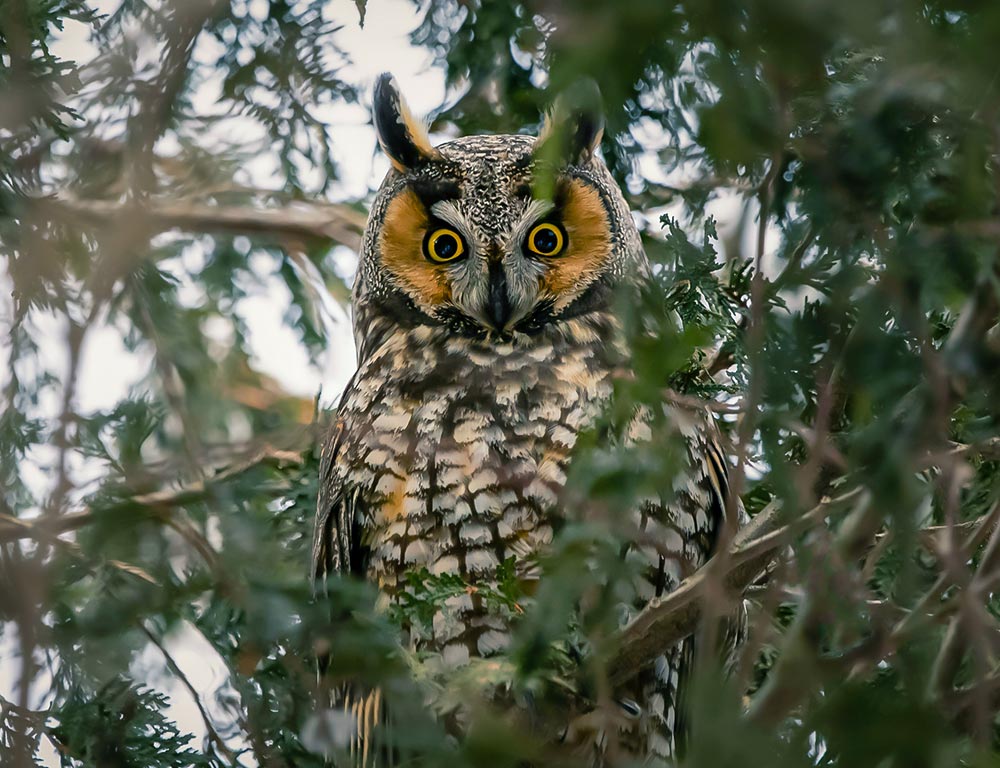
- Scientific name: Asio otus
- Population: Varied, dependent on habitat
- Life span: Up to 10 years
- Size: 13 to 16 inches tall
- Weight: 7 to 16 ounces
- Food: Mainly small mammals like mice, voles, and shrews; also birds and insects
- Wingspan: 35 to 39 inches
- Status: Least Concern
Long-eared Owls are characterized by their prominent ear tufts and are distributed across various habitats, including woodlands, grasslands, and marshes.
They are nocturnal hunters, relying on keen hearing to locate prey. These owls often roost in dense vegetation during the day, camouflaging themselves among branches.
Long-eared Owls are known for their communal roosting behavior, gathering in groups during the non-breeding season. Conservation efforts focus on preserving suitable habitats and ensuring the availability of roosting sites for these elegant owls.
9. Short-eared Owl
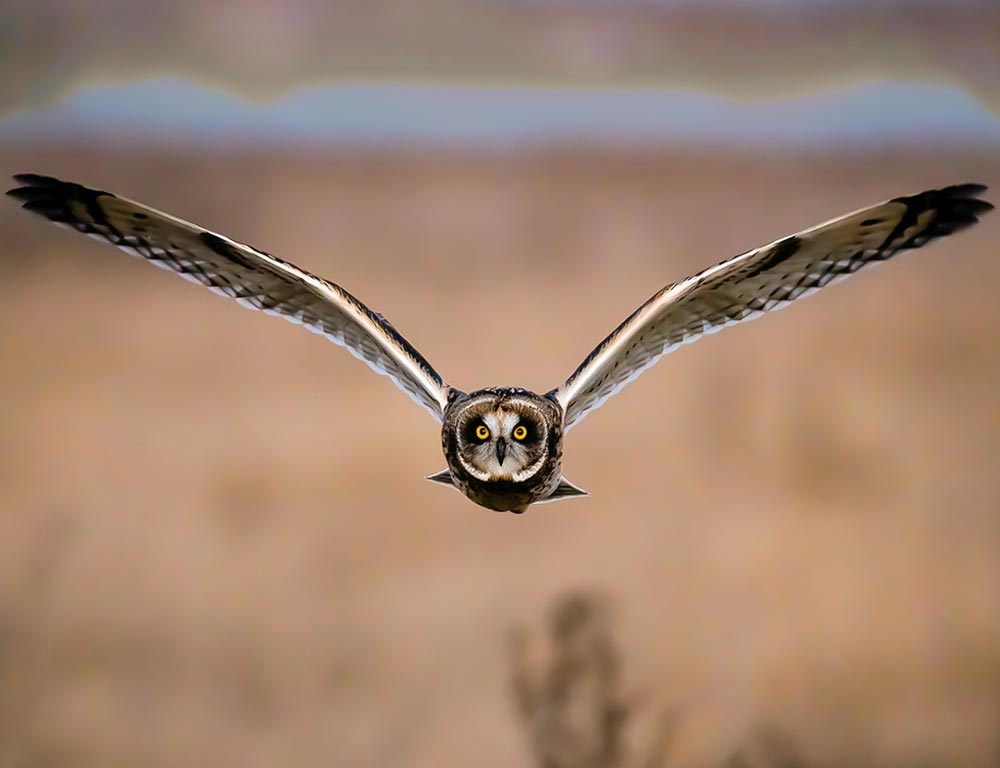
- Scientific name: Asio flammeus
- Population: Variable, influenced by prey abundance
- Life span: Up to 10 years
- Size: 13 to 17 inches tall
- Weight: 7 to 19 ounces
- Food: Small mammals like voles, mice, and shrews; also birds and insects
- Wingspan: 33.5 to 40.5 inches
- Status: Least Concern
Short-eared Owls are known for their distinctive facial disks and preference for open habitats like grasslands, marshes, and tundra.
Unlike many other owls, they are crepuscular, often hunting during twilight. These owls are versatile hunters, capturing prey by flying low over open areas and listening for movement sounds.
Short-eared Owls may also nest on the ground. Conservation efforts involve preserving their diverse habitats and addressing threats like habitat loss and disturbance during the breeding season.
10. Boreal Owl
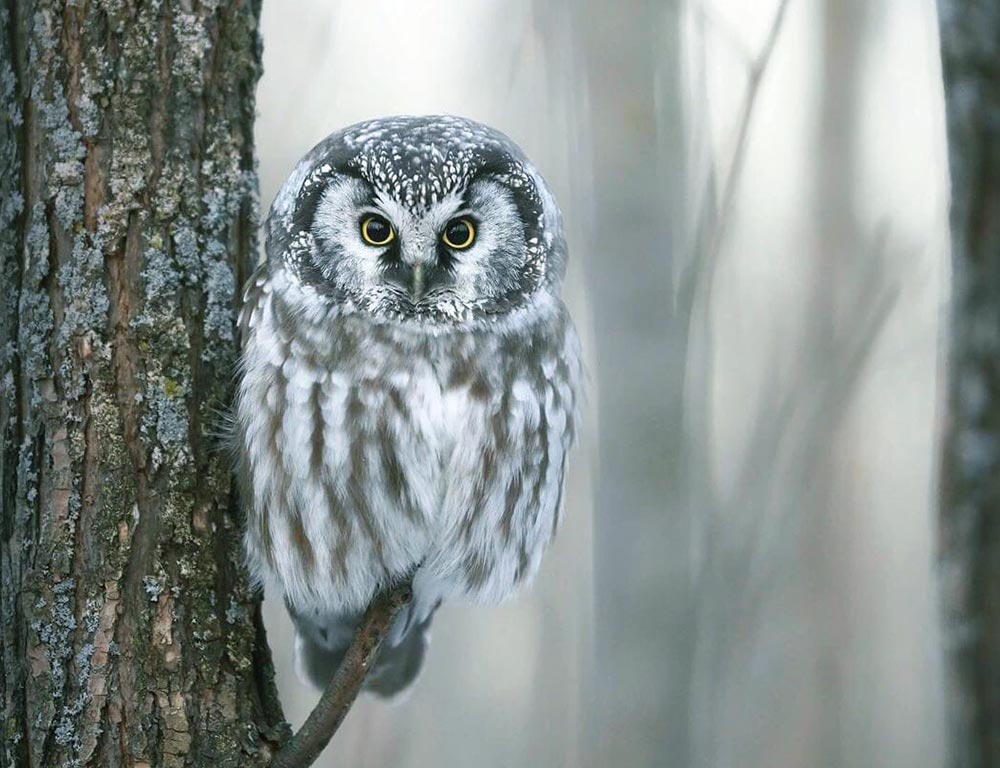
- Scientific name: Aegolius funereus
- Population: Variable, influenced by prey availability
- Life span: Up to 10 years
- Size: 8 to 12 inches tall
- Weight: 3 to 7 ounces
- Food: Small mammals, birds, and insects
- Wingspan: 21 to 24 inches
- Status: Least Concern
The Boreal Owl is adapted to northern forests, including boreal and mountainous regions. These owls are nocturnal hunters who prefer small mammals, birds, and insects.
They often nest in tree cavities, and their plumage provides effective camouflage against the bark of coniferous trees.
Boreal Owls are generally solitary, with pairs coming together during the breeding season. Conservation efforts involve monitoring their populations in response to habitat degradation and climate change threats.
11. Burrowing Owl
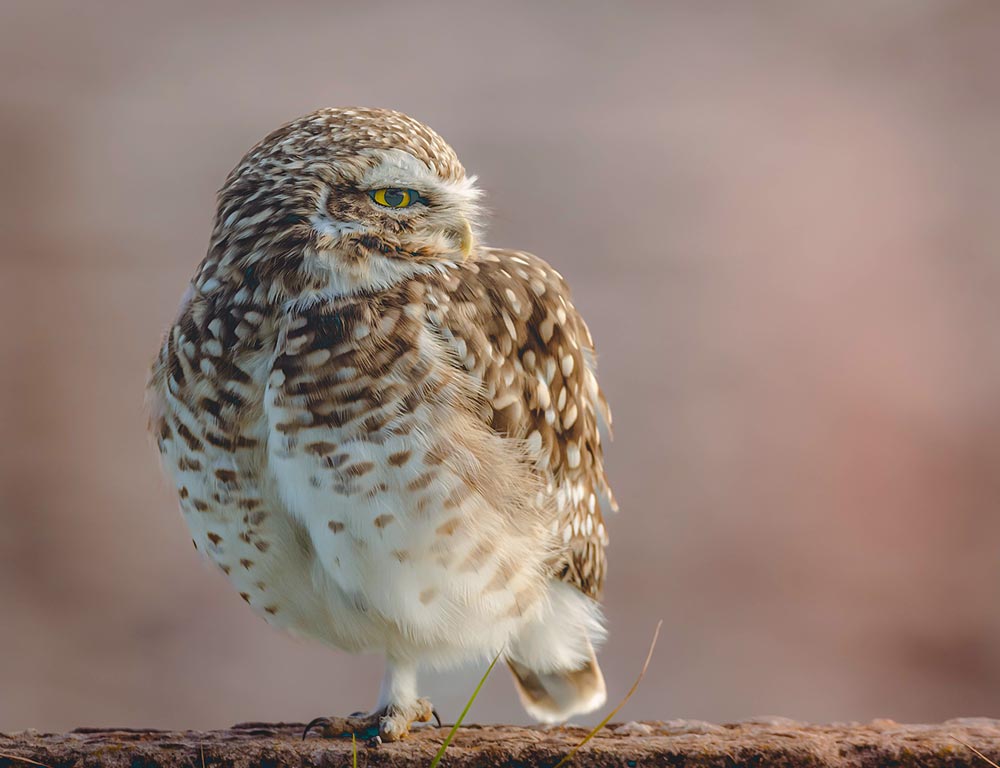
- Scientific name: Athene cunicularia
- Population: Variable, facing some declines
- Life span: 6 to 8 years
- Size: 7 to 11 inches tall
- Weight: 5 to 8 ounces
- Food: Mainly insects, small mammals, and birds
- Wingspan: 21 to 24 inches
- Status: Vulnerable in some regions
Burrowing Owls are unique among owls for their affinity for open habitats and ground-nesting. They inhabit prairies, deserts, and agricultural areas, often utilizing abandoned burrows of mammals like ground squirrels.
These diurnal owls are skilled hunters, targeting a variety of prey. Conservation efforts aim to address threats such as habitat loss, pesticides, and collisions with vehicles.
Preserving suitable nesting sites and raising awareness about the importance of these owls in controlling pest populations are critical components of their conservation.
Ecological Significance of Owls in Wisconsin
With their mysterious nocturnal habits and predatory prowess, owls play a crucial role in Wisconsin’s ecosystems.
Beyond their captivating presence, these avian predators contribute significantly to the delicate balance of nature. Let’s unravel the ecological significance of owls in the diverse landscapes of Wisconsin.
Pest Control Prowess
Owls are adept hunters of rodents and insects, acting as natural pest controllers. Their diet, rich in mice, voles, and other small mammals, helps regulate prey populations, preventing agricultural and forest pest outbreaks.
Biodiversity Guardians
By preying on various species, owls contribute to biodiversity by preventing the dominance of a single prey type. This dynamic balance in the ecosystem ensures the health and sustainability of wildlife communities in Wisconsin.
Habitat Health Indicators
Owls are sensitive to changes in their environment. Monitoring their populations can serve as an indicator of the overall health of ecosystems.
Declines may signal habitat degradation, pollution, or other ecological disturbances.
Seed Dispersion Support
Some owl species inadvertently aid in seed dispersion. After consuming prey like rodents, owls regurgitate pellets containing undigested bones and fur.
These pellets, left in their roosting and nesting sites, contribute to soil fertility and assist in plant growth.
Natural Adaptation to Climate
Owls showcase remarkable adaptability to varying climates. Studying their behavior and movement patterns provides valuable insights into how wildlife copes with environmental changes, offering essential data for climate change research.
Cultural and Educational Value
Beyond their ecological contributions, owls hold cultural significance and serve as educational ambassadors.
Their presence in Wisconsin’s folklore, literature, and educational programs fosters a deeper understanding and appreciation for the interconnectedness of nature among communities.
Wrapping Up
The owls of Wisconsin, with their nocturnal mastery and ecological influence, stand as silent guardians of balance in the state’s diverse landscapes.
Beyond their ethereal allure, these birds contribute indispensably to pest control, biodiversity, and habitat health.
Their adaptability to changing climates offers critical insights, while their presence weaves cultural richness into the tapestry of Wisconsin.
As stewards of the night, owls underscore the intricate web of life, emphasizing the need for conservation efforts to protect their habitats and ensure the perpetuity of these feathered envoys of the wilderness. Thank you so much.